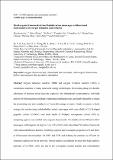Metal-organic-framework-derived hybrid carbon nanocages as bifunctional electrocatalyst for oxygen reduction and evolution
View/
Date
18/08/2017Author
Funder
Grant ID
EP/F019580/1
Keywords
Metadata
Show full item recordAbstract
The oxygen reduction reaction (ORR) and oxygen evolution reaction (OER) are cornerstone reactions for many renewable energy technologies. Developing cheap yet durable substitutes of precious‐metal catalysts, especially the bifunctional electrocatalysts with high activity for both ORR and OER reactions and their streamlined coupling process, are highly desirable to reduce the processing cost and complexity of renewable energy systems. Here, a facile strategy is reported for synthesizing double‐shelled hybrid nanocages with outer shells of Co‐N‐doped graphitic carbon (Co‐NGC) and inner shells of N‐doped microporous carbon (NC) by templating against core–shell metal–organic frameworks. The double‐shelled NC@Co‐NGC nanocages well integrate the high activity of Co‐NGC shells into the robust NC hollow framework with enhanced diffusion kinetics, exhibiting superior electrocatalytic properties to Pt and RuO2 as a bifunctional electrocatalyst for ORR and OER, and hold a promise as efficient air electrode catalysts in Zn–air batteries. First‐principles calculations reveal that the high catalytic activities of Co‐NGC shells are due to the synergistic electron transfer and redistribution between the Co nanoparticles, the graphitic carbon, and the doped N species. Strong yet favorable adsorption of an OOH* intermediate on the high density of uncoordinated hollow‐site C atoms with respect to the Co lattice in the Co‐NGC structure is a vital rate‐determining step to achieve excellent bifunctional electrocatalytic activity.
Citation
Liu , S , Wang , Z , Zhou , S , Yu , F , Yu , M , Chiang , C-Y , Zhou , W , Zhao , J & Qiu , J 2017 , ' Metal-organic-framework-derived hybrid carbon nanocages as bifunctional electrocatalyst for oxygen reduction and evolution ' , Advanced Materials , vol. 29 , no. 31 , 1700874 , pp. 1-10 . https://doi.org/10.1002/adma.201700874
Publication
Advanced Materials
Status
Peer reviewed
ISSN
0935-9648Type
Journal article
Description
This study is partly supported by the National Natural Science Foundation of China (Nos. 51522203, 21336001 and 21361162004). ZW acknowledges the support from the Recruitment Program of Global Youth Experts, Fok Ying Tung Education Foundation (No. 151047) and Xinghai Scholarship of Dalian University of Technology. WZ thanks EPSRC for financial support to the electron microscopy facility (EP/F019580/1).Collections
Items in the St Andrews Research Repository are protected by copyright, with all rights reserved, unless otherwise indicated.

